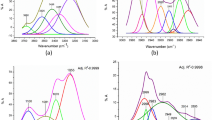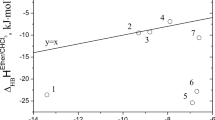Abstract
The molecular association of chloroform with o-cresol compound was studied by quantum chemical calculations using different basis sets (6-31G (d,p), 6–31 + + G (d,p), and 6–311 + + G (d,p)) and their respective counterpoise corrected energies, geometries and frequencies were analyzed. Fourier transform infrared spectroscopy (FTIR) spectra (ATR mode) of chloroform, o-cresol, and the various mole fractions of chloroform: o-cresol (0.8:0.2, 0.6:0.4, 0.4:0.6, and 0.2:0.8) have been recorded at ambient temperature. The quantum chemical calculations of chloroform (monomer, dimer, and trimer) and o-cresol (monomer, dimer, and trimer) and the complex structures of 1:1 and 2:1 (o-cresol: chloroform) were optimized and analyzed using density functional theory (DFT). From the results of FTIR spectroscopy and DFT calculations, the following H-bonds were identified (o-cresol methyl and/or aryl) C-H…Cl (chloroform) and (chloroform) C-H…O and/or π (o-cresol). The trend of theoretical frequencies of the complex structures 2:2 and 2:3 exactly follow the experimental FTIR frequencies. The monomeric and dimeric associations of chloroform and dimeric, trimeric forms of o-cresol are identified.





Similar content being viewed by others
Data Availability
Data will be made available on request.
References
V. Arjunan, S. Mohan, Fourier transform infrared and FT-Raman spectra, assignment, ab initio, DFT and normal co-ordinate analysis of 2-chloro-4-methylaniline and 2-chloro-6-methylaniline. Spectrochim. Acta A Mol. Biomol. Spectrosc 72, 436–444 (2009). https://doi.org/10.1016/j.saa.2008.10.017
M. Hippler, Quantum-chemical study of CH Cl3–SO2 association, J. chem. Phys. 123, 204311 (2005). https://doi.org/10.1063/1.2121609
S. Chung, M. Hippler, Infrared spectroscopy of hydrogen-bonded CH Cl3–SO2 in the gas phase. J. Chem. Phys. 124, 214316 (2006). https://doi.org/10.1063/1.2207617
M. Hippler, S. Hesse, M.A. Suhm, Quantum-chemical study and FTIR jet spectroscopy of CHCl3–NH3 association in the gas phase. Phys. Chem. Chem. Phys. 12(41), 13555–13565 (2010)
X. Nie, X. Liu, C. Song, X. Guo, Brønsted acid-catalyzed tert-butylation of phenol, o-cresol and catechol: A comparative computational study. J. Mol. Catal. 332, 145–151 (2010). https://doi.org/10.1016/j.molcata.2010.09.010
H.S. Biswal, P.R. Shirhatti, S. Wategaonkar, O− H··· O versus O− H··· S hydrogen bonding I: experimental and computational studies on the p-cresol· H2O and p-cresol· H2S complexes. J. Phys. Chem A. 113, 5633–5643 (2009). https://doi.org/10.1021/jp9009355
R. Balaji, M.G. Sankar, M.C. Sekhar, M.C. Shekar, FT-IR Spectroscopic study of excess thermodynamic properties of liquid mixtures containing N-methylformamide with 2-alkoxyethanols at various temperatures. J. Mol. Liq. 216, 330–341 (2016). https://doi.org/10.1016/j.molliq.2015.12.051
N. Sundaraganesan, C. Meganathan, H. Saleem, B.D. Joshua, Vibrational spectroscopy investigation using ab initio and density functional theory analysis on the structure of 5-amino-o-cresol. Spectrochim. Acta A Mol. Biomol. Spectrosc 68, 619–625 (2007). https://doi.org/10.1016/j.saa.2006.12.036
Y. Li, Z. Liu, W. Xue, S.P. Crossley, F.C. Jentoft, S. Wang, Hydrogenation of o-cresol on platinum catalyst: Catalytic experiments and first-principles calculations. Appl. Surf. Sci. 393, 212–220 (2017). https://doi.org/10.1016/j.apsusc.2016.10.028
A. Andersen, Final report on the safety assessment of sodium p-chloro-m-cresol, p-chloro-m-cresol, chlorothymol, mixed cresols, m-cresol, o-cresol, p-cresol, isopropyl cresols, thymol, o-cymen-5-ol, and carvacrol. Int. J. Toxicol 25, 29–127 (2006). https://doi.org/10.1080/10915810600716653
N.H. Williams, W.M. Whitten, orchid floral fragrances and male englossine bees; methods and advances in the sesquidecade, Biol. Bull. 164, 355–395 (1933). https://doi.org/10.2307/1541248
I.G. Tironi, W.F. Van Gunsteren, A molecular dynamics simulation study of chloroform. Mol. Phys 83, 381–403 (1994). https://doi.org/10.1080/00268979400101331
P. Watts, G. Long, M. E. Meek, Chloroform, World Health Organization. 58 (2004)
R. Luo, M.S. Head, J.A. Given, M.K. Gilson, Nucleic acid base-pairing and N-methylacetamide self-association in chloroform: affinity and conformation. Biophys. Chem. 78, 183–193 (1999). https://doi.org/10.1016/S0301-4622(98)00229-4
S. Singh, C.R. Rao, Spectroscopic studies of self-association due to hydrogen bonding. J. Phys. Chem. A 71, 1074–1078 (1967). https://doi.org/10.1021/j100863a044
W.L. Jorgensen, D.L. Severance, Chemical chameleons: hydrogen bonding with imides and lactams in chloroform. J. Am. Chem. Soc. 113, 209–216 (1991). https://doi.org/10.1021/ja00001a030
F. Eblinger, H.J. Schneider, Self-association of water and water− solute associations in chloroform studied by NMR shift titrations. J. Phys. Chem. A 100, 5533–5537 (1996). https://doi.org/10.1021/jp952596w
C.J. Creswell, A.L. Allred, Thermodynamic constants for hydrogen bond formation in the chloroform-benzene-cyclohexane system. J. Phys. Chem. 66, 1469–1472 (1962). https://doi.org/10.1021/j100814a021
B.W. Foster, R.L. Huggins, J. Robeson, E.T. Adams Jr., Mixed association of cholesterol with methyl cholate and methyl lithocholate in chloroform solutions. Biophys. Chem. 16, 317–328 (1982). https://doi.org/10.1016/0301-4622(82)87036-1
F. Takahashi, N.C. Li, Proton Magnetic Resonance Studies of Hydrogen Bonding in Amine-Acetamide-Chloroform Systems1. J. Phys. Chem. A 69, 2950–2954 (1965). https://doi.org/10.1021/j100893a020
W.C. Luo, J.L. Lay, J.S. Chen, NMR study of hydrogen bonding association of some sterically hindered alcohols in carbon tetrachloride, chloroform and cyclohexane. Phys. Chem. Chem. 216, 829–843 (2002). https://doi.org/10.1524/zpch.2002.216.7.829
C.M. Huggins, G.C. Pimentel, J.N. Shoolery, Proton magnetic resonance studies of chloroform in solution: evidence for hydrogen bonding. Chem. Phys. 23, 1244–1247 (1955). https://doi.org/10.1063/1.1742249
L.E. Bromberg, D.P. Barr, Self-association of mucin. Biomacromol 1, 325–334 (2000). https://doi.org/10.1021/bm005532m
A. Coutinho, M. Prieto, Self-association of the polyene antibiotic nystatin in dipalmitoylphosphatidylcholine vesicles: a time-resolved fluorescence study. Biophys. J. 69, 2541 (1995). https://doi.org/10.1016/S0006-3495(95)80125-6
P. Hobza, Z. Havlas, Blue-shifting hydrogen bonds. Chem. Rev. 100, 4253–4264 (2000). https://doi.org/10.1021/cr990050q
G.A. Jeffrey, W. Saenger, Hydrogen bonding in biological structures, Springer Science & Business Media, (1991)
G.A. Jeffrey, G.A. Jeffrey, An introduction to hydrogen bonding, vol. 12 (Oxford University Press, New York, 1997)
G.R. Desiraju, T. Steiner, The weak hydrogen bond: in structural chemistry and biology, Vol. 9. International Union of Crystal, (2001)
A.D. Buckingham, J.E. Del Bene, S.A.C. McDowell, The hydrogen bond. Chem. Phys. Lett. 463, 1–10 (2008). https://doi.org/10.1016/j.cplett.2008.06.060
K. Müller-Dethlefs, P. Hobza, Noncovalent interactions: a challenge for experiment and theory. Chem. Rev. 100, 143–168 (2000). https://doi.org/10.1021/cr9900331
S.J. Grabowski, Hydrogen bonding strength—measures based on geometric and topological parameters. J. Phys. Org. Chem. 17, 18–31 (2004). https://doi.org/10.1002/poc.685
G.R. Desiraju, Hydrogen bridges in crystal engineering: interactions without borders. Acc. Chem. Res. 35, 565–573 (2002). https://doi.org/10.1021/ar010054t
U. Koch, P.L. Popelier, Characterization of CHO hydrogen bonds on the basis of the charge density. J. Phys. Chem. A. 99, 9747–9754 (1995). https://doi.org/10.1021/j100024a016
M. Arivazhagan, V.P. Subhasini, A. Austine, Vibrational spectroscopic, first-order hyperpolarizability and HOMO, LUMO studies of 4-chloro-2-(trifluoromethyl) aniline based on DFT calculations Spectrochim. Acta A Mol. Biomol. Spectrosc. 86, 205–213 (2012). https://doi.org/10.1016/j.saa.2011.10.026
A. Elangovan, R. Shanmugam, G. Arivazhagan, A. Mahendraprabu, N.K. Karthick, Intermolecular forces in acetonitrile+ ethanol binary liquid mixtures. Chem. Phys. Lett. 639, 161–165 (2015). https://doi.org/10.1016/j.cplett.2015.09.022
H.G. Korth, M.I. de Heer, P. Mulder, A DFT study on intramolecular hydrogen bonding in 2-substituted phenols: conformations, enthalpies, and correlation with solute parameters. J. Phys. Chem. A 106, 8779–8789 (2002). https://doi.org/10.1021/jp025713d
R.M.Silverstein, F.X. Webster, D.J. Kiemle, Spectrometric Identification of Organic Compounds, John Wiley & Sons Inc., 2005 N.K. Karthick, G. Arivazhagan, R. Shanmugam, J. Mol. Struct. 1173, 456 (2018). https://doi.org/10.1021/ed039p546
S. Jeyavijayan, Molecular structure, spectroscopic (FTIR, FT-Raman, 13C and 1H NMR, UV), polarizability and first-order hyperpolarizability, HOMO–LUMO analysis of 2, 4-difluoroacetophenone. Spectrochim. Acta Part A Mol. Biomol. Spectrosc. 136, 553–566 (2015)
P.R. Griffiths, J.M. Chalmers, Handbook of vibrational spectroscopy, John Wiley & Sons Inc. (2002)
D.L. Pavia, G.M. Lampman, G.S. Kriz, Introduction to spectroscopy – a guide for students of organic chemistry, Brooks/ Cole- Thomson Learning, (2001)
D.L. Jadhav, N.K. Karthick, P.P. Kannan, R. Shanmugam, A. Elangovan, G. Arivazhagan, Molecular interaction forces in acetone+ ethanol binary liquid solutions: FTIR and theoretical studies. J. Mol. Struct. 1130, 497 (2017). https://doi.org/10.1016/j.molstruc.2016.10.055
J. Stangret, E.K. Piotrowicz, K. Laskowska, In-situ analysis of CO2 electroreduction on Pt and Pt oxide cathodes. Vib. Spectroscopy 44, 324 (2007). https://doi.org/10.5796/electrochemistry.19-00066
I.D.H. Oswald, W.A. Crichton CCDC 698229: experimental crystal structure determination, (2010). https://doi.org/10.5517/ccrfkj7
M. Hippler, Quantum chemical study and infrared spectroscopy of hydrogen-bonded CH Cl3–NH3 in the gas phase. J. Chem. Phys, 127, 084306 (2007). https://doi.org/10.1063/1.2757176
J.A. Plumley, and J.J. Dannenberg, A comparison of the behavior functional/ basis set combinations for hydrogen- bonding in the water dimer with emphasis on basis set superposition error. J. Comput. Chem, 8 (2011):1519-1527
Acknowledgements
I am thankful to Thiagarajar Arts and science college management for providing lab facilities.
Funding
B. Sahaya Infant Lasalle is supported by the management of Sri Sivasubramaniya Nadar College of Engineering through SSN Senior Research Assistant (SRA) fellowship.
Author information
Authors and Affiliations
Corresponding author
Ethics declarations
Conflict of Interest
The authors declare no competing interests.
Additional information
Publisher's Note
Springer Nature remains neutral with regard to jurisdictional claims in published maps and institutional affiliations.
Rights and permissions
Springer Nature or its licensor (e.g. a society or other partner) holds exclusive rights to this article under a publishing agreement with the author(s) or other rightsholder(s); author self-archiving of the accepted manuscript version of this article is solely governed by the terms of such publishing agreement and applicable law.
About this article
Cite this article
Lasalle, B.S.I., Pandian, M.S. & Ramasamy, P. Molecular Interactions Studies on Chloroform in the Environment of o-Cresol: FTIR Spectroscopy and Quantum Chemical Calculations. Braz J Phys 53, 97 (2023). https://doi.org/10.1007/s13538-023-01309-6
Received:
Accepted:
Published:
DOI: https://doi.org/10.1007/s13538-023-01309-6




